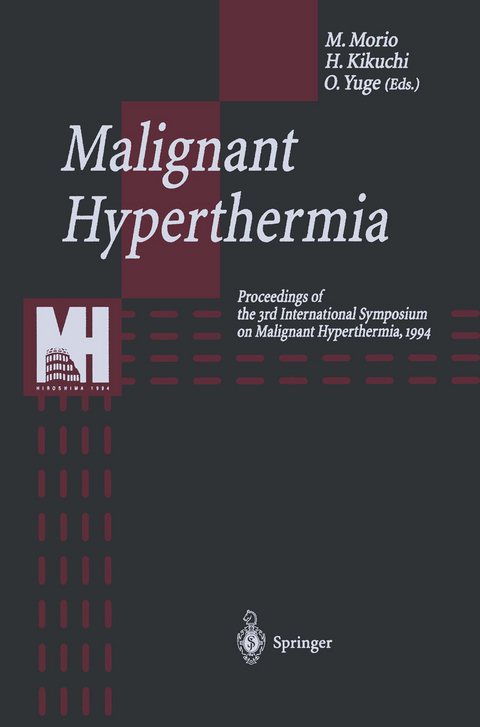
Malignant Hyperthermia
Springer Verlag, Japan
978-4-431-68348-3 (ISBN)
In susceptible individuals, malignant hyperthermia (MH) can be triggered by various anesthetics during surgery. First described in 1960, research since then has concentrated on reducing the very high mortality rate associated with MH. Although significant progress in treatment has been made with the introduction of dantrolene sodium in 1979, many questions remain unanswered. Following on the results of more than 30 years of investigative efforts, the Third International Symposium on MH was held in Hiroshima, Japan, in 1994, immediately before the Seventh International Workshop on MH. Specialists in the field discussed the most up-to-date findings from the point of view of clinical classification, history, and incidence based on the evidence of epidemiology, diagnostic muscle testing, genetics, and biochemistry. These proceedings of the symposium present important keys to understanding the mechanism of MH and related syndromes at the genetic level and include procedures for the monitoring and care of patients. This volume will be invaluable not only for surgeons and anesthesiologists but also for physiologists and researchers.
1. History of Malignant Hyperthermia.- History of Malignant Hyperthermia.- 2. Clinical Classification and Incidence of Fulminant and Abortive Malignant Hyperthermia.- The Incidence of Malignant Hyperthermia in Denmark.- Malignant Hyperthermia in Austria 1984–1993.- Clinical Classification and Incidence of Fulminant and Abortive Malignant Hyperthermia Reactions in Italy.- The Epidemiology of Malignant Hyperthermia Events in North America.- Clinical Classification and Incidence of Malignant Hyperthermia in Australia.- Clinical Classification and Incidence of Malignant Hyperthermia in Japan.- 3. Muscular Testing for Malignant Hyperthermia.- Testing for Malignant Hyperthermia in North America and Australia.- Muscular Testing of Malignant Hyperthermia in Europe.- Caffeine Contracture of the Skinned Muscle Fiber in Malignant Hyperthermia and Neuromuscular Diseases.- Calcium-Induced Calcium Release Test (Abstract).- 4. Genetic Study of Malignant Hyperthermia.- Mutations in the Skeletal Muscle Ryanodine Receptor (RYR1) Gene Are Linked to Malignant Hyperthermia and Central-Core Disease.- Chromosome 17 Candidate Gene Analysis in a Population Referred Because of Suspected Susceptibility to Malignant Hyperthermia.- Disease Expression and Gene Expression Can Be Quite Distinct: Modulation of Skeletal Muscle Sodium Channels by the Human Myotonin Dystrophy Protein Kinase (HMPK).- 5. Biological Study of Malignant Hyperthermia.- Intracellular Calcium Release Channels in Muscles Related to Excitation-Contraction-Coupling and Malignant Hyperthermia (Abstract).- Metabolism of Inositol Polyphosphates by Malignant Hyperthermia-Susceptible and Control Porcine Skeletal Muscle.- Fatty Acids: Potentially Crucial Modulators of the Malignant Hyperthermia Syndrome.- Mitochondrial Disorders inMalignant Hyperthermia.- Muscle Mitochondria and Malignant Hyperthermia.- 6. Malignant Hyperthermia Related Syndromes.- Association Between Malignant Hyperthermia and Severe, Chronic Muscle Pain.- Porcine Malignant Hyperthermia.- Vitamin E and Porcine Malignant Hyperthermia.- Malignant Hyperthermia in Dogs.- Heatstroke.- Intracellular Calcium Mechanism in the Pathogenesis of Neuroleptic Malignant Syndrome.- Controversies in the Pathogenesis of Neuroleptic Malignant Syndrome.- Neuromuscular Disorders and Malignant Hyperthermia.- 7. Therapy of Malignant Hyperthermia.- Updated Therapy of Malignant Hyperthermia.- 8. Free Discussion.- “What Is Malignant Hyperthermia?”.
| Erscheint lt. Verlag | 20.4.2014 |
|---|---|
| Zusatzinfo | XV, 256 p. |
| Verlagsort | Tokyo |
| Sprache | englisch |
| Maße | 155 x 235 mm |
| Themenwelt | Medizin / Pharmazie ► Medizinische Fachgebiete ► Anästhesie |
| Schlagworte | etiology • Malignant Hyperthermia • Treatment |
| ISBN-10 | 4-431-68348-8 / 4431683488 |
| ISBN-13 | 978-4-431-68348-3 / 9784431683483 |
| Zustand | Neuware |
| Haben Sie eine Frage zum Produkt? |
aus dem Bereich


